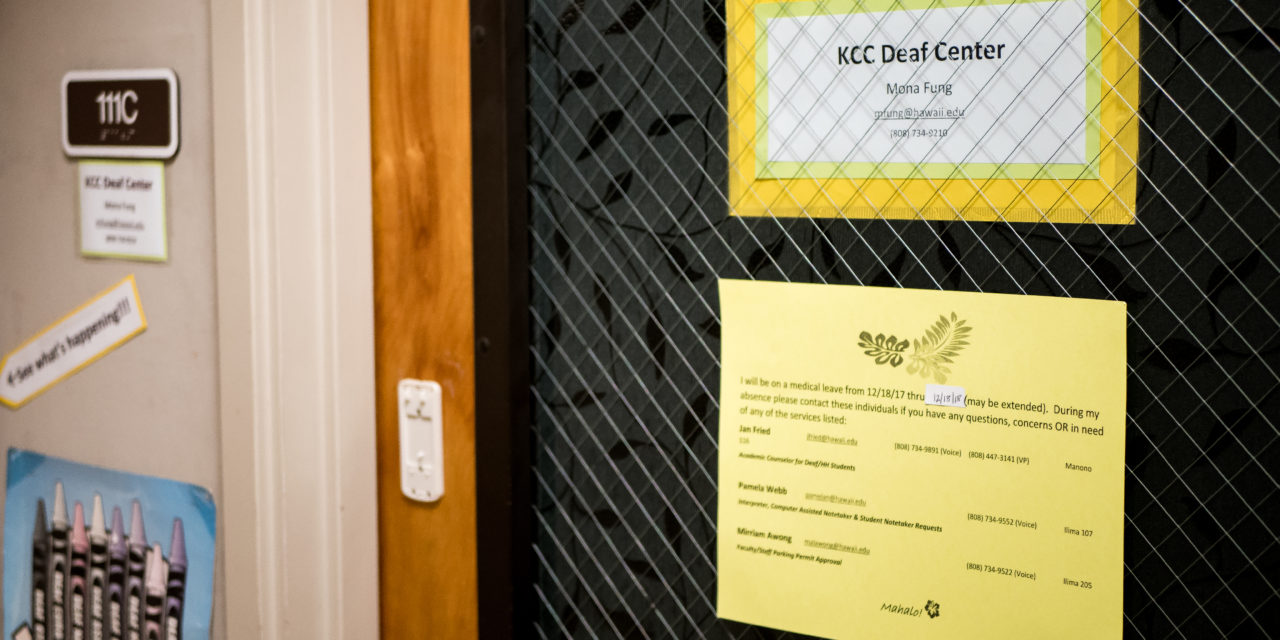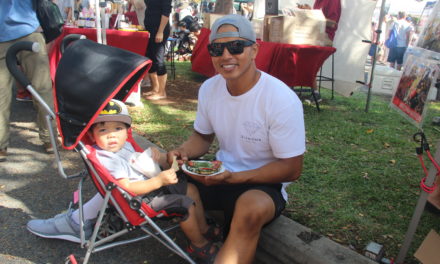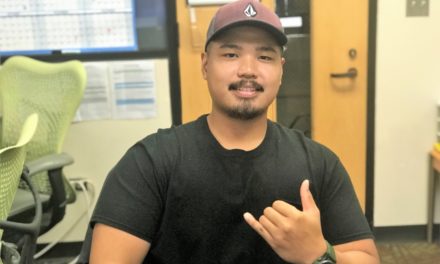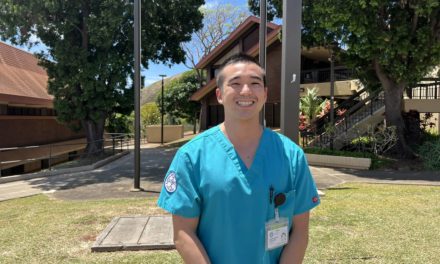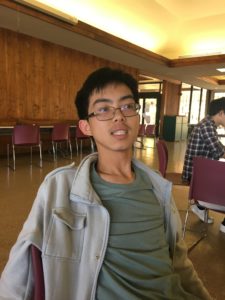By Mark Ladao | Staff Writer
Kapi‘olani Community College is well-known within the University of Hawai‘i system for several of the programs it offers, including its Culinary Arts and Emergency Medical Technician programs, but relatively overlooked are its American Sign Language offerings.
Through its ASL courses and services for deaf, hard of hearing and deaf-blind people, KCC is helping build support for the deaf community in Hawai‘i and for Hawaiian Sign Language, which the University of Hawai‘i at Mānoa determined to be a unique language in 2013.
Support for the Deaf community
KCC has the most robust ASL course offerings within the university system, offering four levels of ASL, and allowing students to fulfill their second language requirements through ASL. For perspective, this fall, UH Mānoa and Honolulu Community College will offer their first ASL courses since the 1980s, and a few introductory, non-credit courses exist in colleges in Kaua‘i and Maui.
Located at KCC is the Kapi‘olani Deaf Center, which it touts as “the only deaf-related center in the University of Hawai’i system.” The KDC focuses on support for those who are deaf, hard of hearing or deaf-blind; interpreting; counseling services; and outreach to the community.
Even further, the majority of faculty who teach ASL are deaf themselves.
One of those instructors is Emily Jo Noschese. Noschese said that the courses taught at KCC has made made living in Hawai‘i as a deaf person much easier.
“Everywhere we go, there’s somebody who would know ASL,” she said via email.
Jan Fried, the only hearing ASL instructor at KCC and the coordinator for the school’s Interpreter Education program, said it is important that ASL is taught by deaf people rather than hearing people.
When students have a deaf instructor, they are better exposed to deaf culture, and deaf people have the ability to teach it how they see fit. Noschese attributes many of her positive experiences regarding Hawaiʻi’s attitude toward deaf people to KCC.
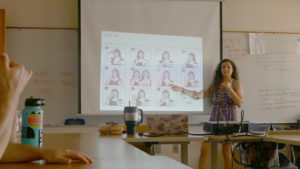
Emily Jo Noschese teaches several ASL courses at KCC and will teach at KCC and UH Mānoa in the Fall 2018 semester. (Photo by Mark Ladao)
“[W]e get excited when we see that they’re trying!” Noschese wrote about people who try to communicate with her through ASL. “Also them learning about deaf culture and knowing that being deaf is OKAY put [sic] ease on the deaf community because we get allies.”
Ongoing support is important because the deaf community is often viewed as if it was a disabled community rather than a cultural one.
“Deaf people aren’t disabled,” said Fried.
Decisions are often made for deaf people by hearing people who might have little or no insight about the deaf community.
James “Woody” Woodward, a linguist and part-time UH Mānoa professor who specializes in documentation of endangered sign languages, particularly in nations in the Pacific, has noticed an “unconscious discrimination” of deaf people.
“If you have hearing and deaf people applying for the same job with the same qualifications, a lot of times, you know, people are going to go with the hearing candidate because they can answer the telephone, take dictation, do other things like that,” he said. “That’s not always the case, but that does tend to happen.”
Woodward also described the views people have of deaf people by the way they talk about deafness — as something that is “diagnosed” or requires “early intervention.”
“It’s the terms we use to describe deaf people and sign languages. We often talk about deafness being ‘diagnosed,’” he said. “How about deafness being ‘identified’?”
Revitalization of Hawaiian Sign Language
KCC’s strong support for deaf culture has also provided a launching pad for the revitalization of Hawaiian Sign Language. Linda Lambrecht, a former ASL instructor at KCC who Fried has called the “keeper” of HSL, intermittently held non-credit HSL workshops through the school’s Office of Continuing Education & Training during her more than 20 years as an ASL instructor.
It was Lambrecht’s insistence that HSL was not a regional variation of ASL that eventually brought Woodward, who was doing similar documentation work in different Asian countries, to Hawai‘i in 2012 to finally determine that HSL is actually a distinct language.
Before this, Fried and Lambrecht recorded videos of Lambrecht signing in HSL, which Fried said was referred to as “signs of the islands” at the time.
“I’m one of those people who thought, ‘I think this is a dialect of ASL,’” she said.
The videos, VHS tapes that were inadvertently played on dirty VCR heads, contained anywhere from six to 12 hours of footage that could help Lambrecht’s revitalization efforts. Fried is still looking to get the VHS tapes cleaned.
In a 2017 issue of “Power of ASL,” a newsletter for the Society of American Sign Language, Woodward and Lambrecht discuss how HSL is a distinct language rather than a dialect of ASL. Using the Swadesh word list, which compares basic vocabulary words between languages, they found that HSL well exceeds the requirements to be distinguished as its own language.
Woodward and Lambrecht have been the primary documenters of HSL grammar and vocabulary ever since. One manifestation of their documentation has come in the form handbooks — which can be used to teach formal language courses in HSL as opposed to the workshops Lambrecht has done at KCC.
Both Woodward and Fried believe there are no longer people who use HSL as their primary language, although Lambrecht said that there are a few people she speaks to on O‘ahu who still primarily use HSL.
“They choose to use it because it’s their comfort language,” she said via an interpreter.
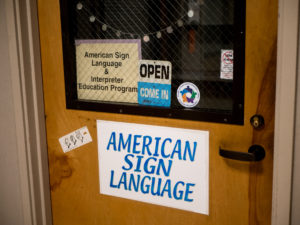
KCC offers an American Sign Language & Interpreter Education Program, which is coordinated by Jan Fried. (Photo by Mark Ladao)
Nevertheless, Woodward has describe HSL as a “critically endangered” language and has emphasized how important it is to document.
Despite the hours of essentially lost video of HSL, the handbooks still have plenty of material. Woodward estimated the handbook has about 1000 words and 20 grammar lessons, which he believes is about a semester-and-a-half’s worth of material if HSL were to be taught in a classroom.
One of the difficulties in revitalizing HSL is the rift in the Hawaiʻi’s deaf community regarding Lambrecht’s documentation methods as well as HSL’s legitimacy as a language in general.
Many of the words in the HSL handbook, which Lambrecht hopes to teach in a potential HSL course at UH Mānoa, originated as one of Lambrecht’s memories. Lambrecht learned HSL as a child and spoke HSL with her family growing up.
She said many words are confirmed by consulting with other HSL users in the state, but some disagree with some of the signs she has presented.
Others have a negative outlook of HSL in general, seeing it “as a lower form of language” and instead preferring ASL. Lambrecht said some people view HSL as hearing people do local “pidgin,” creolized English that’s spoken in Hawaiʻi.
Others still, said Lambrecht, are not even interested in revitalization of HSL.
Assessing the fate of HSL
Among those familiar with HSL revitalization efforts, there appears to be a cautious optimism about the language’s fate.
“There’s certainly still time to document it, but is it going to be enough time to conserve it, to start to revitalize it?” Woodward said. “I hope so. I don’t think it’s too late yet, but we’re kind of getting to a critical balance point, because there’s so few users of HSL.”
“A language is revitalized when it’s normalized, when it’s pervasive,” Fried said. “And it is far from being pervasive.”
Noschese, who has only been in Hawai‘i for a few years, is a big supporter of the current HSL revitalization movement.
“HSL has a lot of culture based in it so … I support it,” she said via email. “It’s a language, I support all languages.”
Lambrecht is planning on using a draft of the HSL handbook she and Woodward have been working on for fall courses at Hawaiʻi’s Comprehensive Service Center. She said she will be teaching HSL at the CSC, to about 20 people who are ASL interpreters, deaf or both.
Regarding KCC, Lambrecht hopes the school will use more video material to help students immerse themselves in the language.
“It has to be a hands-on type of exposure,” she said.
Though Woodward is currently away from Hawai‘i and Lambrecht is retired and busy with personal matters, she is still looking over the HSL handbook, noting mistakes she hopes to get fixed before her courses in the fall.

